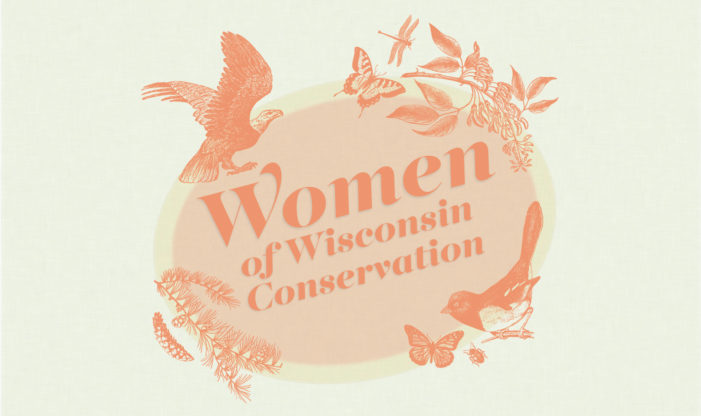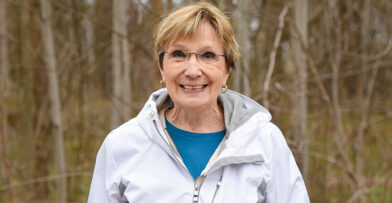Women have contributed greatly to Wisconsin conservation efforts, including making scientific discoveries, conserving habitats, protecting wildlife, and sharing their knowledge with others. Though female conservationists are involved in much impactful work in the state, they have been an under-represented group within the field. According to Data USA, 78.5% of conservation scientists and foresters in the US are male. As recently as the 1940s, there were almost no women working professionally in Wisconsin conservation. Because of outstanding contributions by women in the field, however, progress toward greater female representation is being made.
Women Conservationists from the Past
The conservation movement in Wisconsin has many luminaries, including female trailblazers from the past contributing to a field that was traditionally inhabited only by men. We have chosen just a few to highlight, all of whom have been inducted into the Wisconsin Conservation Hall of Fame.
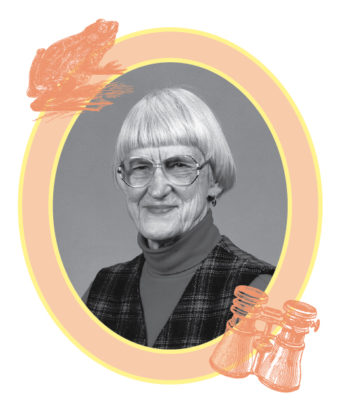 In 1949, Ruth Hine was the first woman to get a Ph.D. in zoology from UW-Madison and is recognized as the first woman to work in a Wisconsin conservation organization. She oversaw the technical editing and writing of research reports from 1949-84 at the Wisconsin Department of Natural Resources (WiDNR). Ruth was a leader in the development of the state’s endangered species program, chairing the committee that created Wisconsin’s first endangered species list. She pioneered the observation of frogs and called for a list of sightings of Wisconsin animals, setting up a system for keeping records to facilitate the work.
In 1949, Ruth Hine was the first woman to get a Ph.D. in zoology from UW-Madison and is recognized as the first woman to work in a Wisconsin conservation organization. She oversaw the technical editing and writing of research reports from 1949-84 at the Wisconsin Department of Natural Resources (WiDNR). Ruth was a leader in the development of the state’s endangered species program, chairing the committee that created Wisconsin’s first endangered species list. She pioneered the observation of frogs and called for a list of sightings of Wisconsin animals, setting up a system for keeping records to facilitate the work.
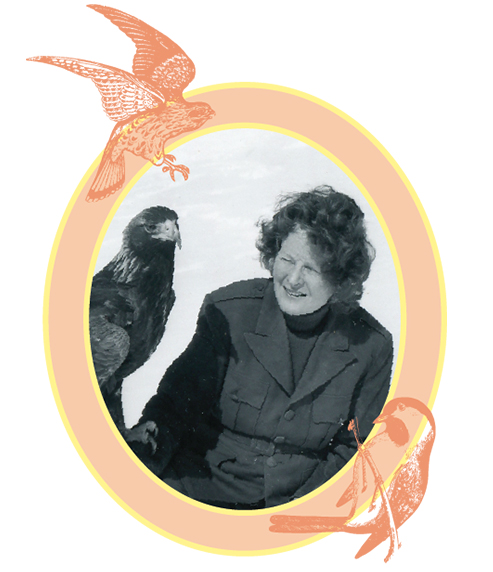 Frances Hamerstrom was the only woman to receive a master’s degree (wildlife management, 1940) from Aldo Leopold at UW-Madison. She was the second woman to work in Wisconsin conservation professionally, starting at the WiDNR in 1949 and staying there for 23 years. An ornithologist and licensed falconer, Frances was employed by the WiDNR as assistant leader of the Prairie Grouse Management Research Unit, where she focused on the habitat needs of the Greater Prairie-Chicken. She and her husband Frederick’s work saved this species from near extinction in Wisconsin. In 1970, the Hamerstroms received the National Wildlife Federation Award for Distinguished Service to Conservation for work with the Greater Prairie-Chickens.
Frances Hamerstrom was the only woman to receive a master’s degree (wildlife management, 1940) from Aldo Leopold at UW-Madison. She was the second woman to work in Wisconsin conservation professionally, starting at the WiDNR in 1949 and staying there for 23 years. An ornithologist and licensed falconer, Frances was employed by the WiDNR as assistant leader of the Prairie Grouse Management Research Unit, where she focused on the habitat needs of the Greater Prairie-Chicken. She and her husband Frederick’s work saved this species from near extinction in Wisconsin. In 1970, the Hamerstroms received the National Wildlife Federation Award for Distinguished Service to Conservation for work with the Greater Prairie-Chickens.
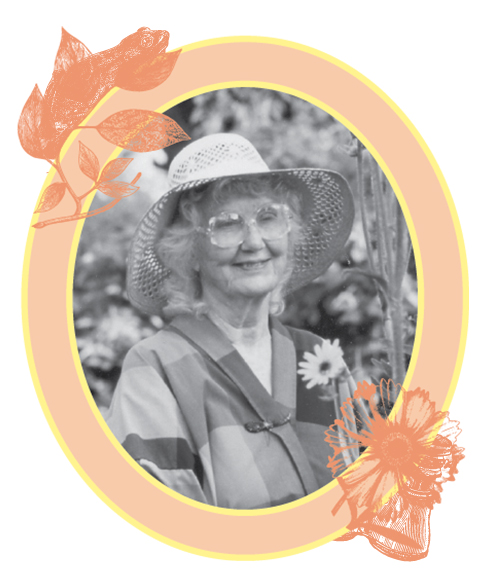 Locally, Lorrie Otto is probably best known for her activism toward banning DDT in Wisconsin, which she became involved in after observing many birds dying unexpectedly on her Bayside property. Her tenacity helped convene scientists, attorneys and witnesses from the US, Canada, and Sweden to present at hearings on the subject, which eventually helped get DDT banned in Wisconsin in 1970. This led to a nationwide ban two years later.
Locally, Lorrie Otto is probably best known for her activism toward banning DDT in Wisconsin, which she became involved in after observing many birds dying unexpectedly on her Bayside property. Her tenacity helped convene scientists, attorneys and witnesses from the US, Canada, and Sweden to present at hearings on the subject, which eventually helped get DDT banned in Wisconsin in 1970. This led to a nationwide ban two years later.
But she accomplished a great deal more as well. Lorrie’s property in Bayside was the first in the area to feature natural landscaping. After the banning of DDT, Lorrie turned her attention to the growing movement in this area. A lover of plants, she worked to preserve native plant species and eventually was the inspiration for the founding of Wild Ones, a national non-profit group that shares information about and advocates for natural landscaping. She received many awards from organizations for her conservation work including the National Audubon Society and the National Wildlife Federation.
Women Conservationists of the Present
Following in these women’s footsteps, more women are currently working toward a healthy Wisconsin by leading organizations or departments that specialize in sustaining and revitalizing the environment. Here are just a few.
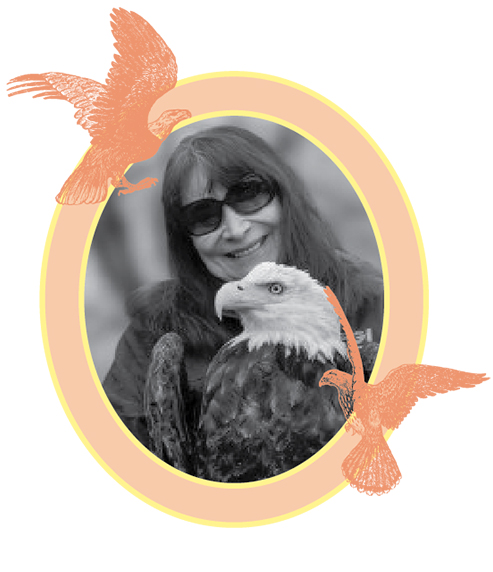 Marge Gibson of Antigo, WI founded and leads the Raptor Education Group, Inc. (REGI), a non-profit organization dedicated to the care and rehabilitation of injured or orphaned native bird species, as well as public education of wildlife issues. Marge is considered one of the top wildlife rehabilitators in our region and is recognized as an authority on Bald Eagles. REGI has rehabilitated and released more than 1000 Bald Eagles in Wisconsin since being founded in 1990. A number of our Center’s raptors, including Glory, our Bald Eagle, have come from REGI. Marge has also been part of a task force of experts working to determine what is causing Wisconsin River eagle syndrome, a mysterious illness that is killing Bald Eagles in the region.
Marge Gibson of Antigo, WI founded and leads the Raptor Education Group, Inc. (REGI), a non-profit organization dedicated to the care and rehabilitation of injured or orphaned native bird species, as well as public education of wildlife issues. Marge is considered one of the top wildlife rehabilitators in our region and is recognized as an authority on Bald Eagles. REGI has rehabilitated and released more than 1000 Bald Eagles in Wisconsin since being founded in 1990. A number of our Center’s raptors, including Glory, our Bald Eagle, have come from REGI. Marge has also been part of a task force of experts working to determine what is causing Wisconsin River eagle syndrome, a mysterious illness that is killing Bald Eagles in the region.
 August Ball had a decade long career in the environmental field before founding Cream City Conservation and Consulting in Milwaukee. August saw a lack of people of color in conservation leadership positions. Her company addresses this through a two-pronged approach; consulting and corps work. Her consulting branch strives to promote an equitable and diverse workplace, while the corps is part of a green job pipeline for Milwaukee’s youth. Cream City’s influence is seen in local and national organizations that are involved with green infrastructure, creating greenspace, managing invasive species, and more. August can be seen as a facilitator in racial equality, bringing companies to try and figure out how to be more inclusive of people of different races. She also served on Governor Evers’ Task Force on Climate Change.
August Ball had a decade long career in the environmental field before founding Cream City Conservation and Consulting in Milwaukee. August saw a lack of people of color in conservation leadership positions. Her company addresses this through a two-pronged approach; consulting and corps work. Her consulting branch strives to promote an equitable and diverse workplace, while the corps is part of a green job pipeline for Milwaukee’s youth. Cream City’s influence is seen in local and national organizations that are involved with green infrastructure, creating greenspace, managing invasive species, and more. August can be seen as a facilitator in racial equality, bringing companies to try and figure out how to be more inclusive of people of different races. She also served on Governor Evers’ Task Force on Climate Change.
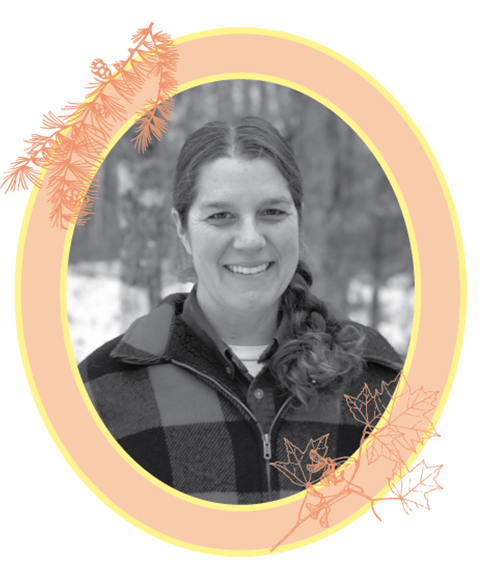 In October 2020, Heather Berklund was named WiDNR’s Forestry Division’s chief state forester, the first woman to lead the department in its 116-year history. Her love of the Wisconsin land, and a desire to be outdoors led her to study forestry. Starting work at the WiDNR in 2000, Berklund was a field forester in a number of Wisconsin locales and served in various supervisory/leadership roles since 2012. Her extensive background in forestry, working with people, and understanding of how new technologies can help her field gives her the expertise to lead effectively. Her desire to prioritize diversity, both in gender and in ethnicity, makes her a trailblazer in Wisconsin. She also hopes to continue to grow partnerships and collaborations across the state to ensure a vibrant future for Wisconsin’s forests.
In October 2020, Heather Berklund was named WiDNR’s Forestry Division’s chief state forester, the first woman to lead the department in its 116-year history. Her love of the Wisconsin land, and a desire to be outdoors led her to study forestry. Starting work at the WiDNR in 2000, Berklund was a field forester in a number of Wisconsin locales and served in various supervisory/leadership roles since 2012. Her extensive background in forestry, working with people, and understanding of how new technologies can help her field gives her the expertise to lead effectively. Her desire to prioritize diversity, both in gender and in ethnicity, makes her a trailblazer in Wisconsin. She also hopes to continue to grow partnerships and collaborations across the state to ensure a vibrant future for Wisconsin’s forests.
Women in Schlitz Audubon’s History
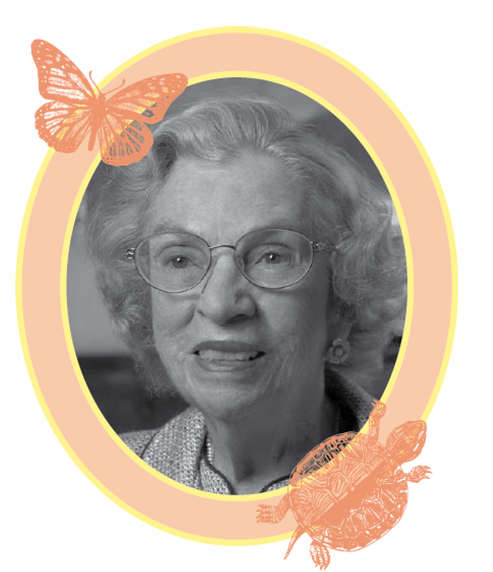 For over 10 years, Dorothy (Dory) Vallier advocated to the Schlitz Foundation for her grandfather’s former home, the Uihlein’s Schlitz Brewery Farm, to be converted to an environmental education center for local school children. The Schlitz Foundation had originally considered developing the land into condominiums, or a men’s-only golf course. In 1969, a number of local women, including Charlotte Zieve, Winifred Woodmansee, and Monnie Messinger, joined Dory in her efforts. They organized Citizens for the Nine Mile Farm Nature Center, sponsoring meetings and polls to establish a favorable climate of public opinion. In 1971, the Schlitz Foundation directors gave their unanimous support to the nature center and the 185 acres of land was donated to the National Audubon Society. Dorothy Vallier led the effort to provide the funds necessary to run our Center as an independent organization, establishing the nature center we all love today.
For over 10 years, Dorothy (Dory) Vallier advocated to the Schlitz Foundation for her grandfather’s former home, the Uihlein’s Schlitz Brewery Farm, to be converted to an environmental education center for local school children. The Schlitz Foundation had originally considered developing the land into condominiums, or a men’s-only golf course. In 1969, a number of local women, including Charlotte Zieve, Winifred Woodmansee, and Monnie Messinger, joined Dory in her efforts. They organized Citizens for the Nine Mile Farm Nature Center, sponsoring meetings and polls to establish a favorable climate of public opinion. In 1971, the Schlitz Foundation directors gave their unanimous support to the nature center and the 185 acres of land was donated to the National Audubon Society. Dorothy Vallier led the effort to provide the funds necessary to run our Center as an independent organization, establishing the nature center we all love today.
Dory’s conservation impact stretches throughout Wisconsin and beyond. She was a two-term board member of National Audubon Society and donated a wetland parcel, “Dory’s Bog,” to become a state-designated scientific research area in Sarona, WI. She and her husband Jacque also donated a 1200-acre tract of land called Treehaven to UW-Stevens Point, and the university subsequently became a leader in natural resources education and professional development. Later, the Dorothy and Jacque Vallier Chair of Ecology in the College of Natural Resources was created there, funded by the Valliers. She and her husband were inducted into the Wisconsin Conservation Hall of Fame in 2010. Truly a life-long environmentalist, Dorothy Vallier died in 2013 at the age of 103.
Throughout our Center’s five decades, countless staff have worked to carry out Dory’s vision to provide environmental education for the community. One such woman was Elizabeth (Buffy) Cheek who was Executive Director for 19 years. During her tenure, the Center achieved major milestones, including the building of Wisconsin’s first Gold LEED-certified building. Our Environmental Learning Center was built in 2003 and is named after Dorothy Vallier. A part of this building plan included a Nature Preschool, which expanded Dory’s desire to connect with nature to the youngest members of our community. Our preschool continues to be a model for others throughout the nation.
As we celebrate 50 years since Dory and others secured these 185 acres for our nature center, dedicated staff and volunteers continue to conserve our land’s diverse habitats and provide meaningful experiences and environmental education for all. Under the leadership of our current Executive Director, Helen Boomsma, we are making nature and nature-based programming accessible to more and more people each year. We are also cultivating a love of nature in future conservationists and laying the groundwork for the Center to continue to flourish in the next 50 years.
The future of Wisconsin conservation has been shaped by these women and others. We hope that their stories will inspire you to get more involved in the conservation movement.
Written with insight from Nancy Quinn and Zoe Finney. Updated on March 20, 2025.
Sources:
Wisconsin Conservation Hall of Fame, Raptor Education Group, Inc., Cream City Conservation and Consulting, Wisconsin DNR, and others
Photo Credits:
Images of Ruth Hine, Frances Hamerstrom, and Lorrie Otto provided by the Wisconsin Conservation Hall of Fame
Image of Marge Gibson by www.featheredhope.net
Image of August Ball by Christopher Hyler
Image of Heather Berklund provided by Wisconsin DNR
